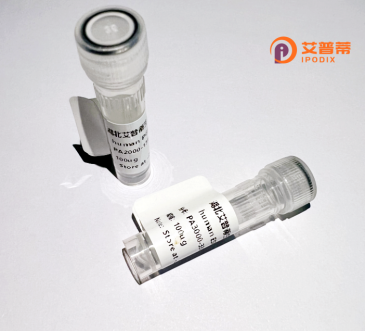
| 纯度 | >90%SDS-PAGE. |
| 种属 | Human |
| 靶点 | RASD1 |
| Uniprot No | Q9Y272 |
| 内毒素 | < 0.01EU/μg |
| 表达宿主 | E.coli |
| 表达区间 | 1-278 aa |
| 活性数据 | MKLAAMIKKM CPSDSELSIP AKNCYRMVIL GSSKVGKTAI VSRFLTGRFE DAYTPTIEDF HRKFYSIRGE VYQLDILDTS GNHPFPAMRR LSILTGDVFI LVFSLDNRDS FEEVQRLRQQ ILDTKSCLKN KTKENVDVPL VICGNKGDRD FYREVDQREI EQLVGDDPQR CAYFEISAKK NSSLDQMFRA LFAMAKLPSE MSPDLHRKVS VQYCDVLHKK ALRNKKLLRA GSGGGGGDPG DAFGIVAPFA RRPSVHSDLM YIREKASAGS QAKDKERC |
| 分子量 | 31.6 kDa |
| 蛋白标签 | His tag N-Terminus |
| 缓冲液 | PBS, pH7.4, containing 0.01% SKL, 1mM DTT, 5% Trehalose and Proclin300. |
| 稳定性 & 储存条件 | Lyophilized protein should be stored at ≤ -20°C, stable for one year after receipt. Reconstituted protein solution can be stored at 2-8°C for 2-7 days. Aliquots of reconstituted samples are stable at ≤ -20°C for 3 months. |
| 复溶 | Always centrifuge tubes before opening.Do not mix by vortex or pipetting. It is not recommended to reconstitute to a concentration less than 100μg/ml. Dissolve the lyophilized protein in distilled water. Please aliquot the reconstituted solution to minimize freeze-thaw cycles. |
以下是关于重组人RASD1蛋白的3篇代表性文献摘要(部分信息为综合概述):
---
1. **文献名称**: *RASD1. a small G protein with a big role in cellular stress adaptation*
**作者**: Cismowski MJ, et al.
**摘要**: 研究揭示RASD1作为非典型Ras超家族G蛋白,在糖皮质激素信号和氧化应激反应中的调控作用,探索其与G蛋白偶联受体的互作机制。
---
2. **文献名称**: *Crystal structure of human RASD1 reveals a constitutively active conformation*
**作者**: Vaidyanathan G, et al.
**摘要**: 通过X射线晶体学解析了人RASD1蛋白的三维结构,发现其具有组成性激活的GTPase结构域,提示其可能独立于传统GTP/GDP循环发挥功能。
---
3. **文献名称**: *Dexras1 (RASD1) modulates dopamine receptor signaling and psychiatric behaviors*
**作者**: Rahman Z, et al.
**摘要**: 探讨RASD1在中枢神经系统中的作用,证明其通过与多巴胺受体相互作用影响突触可塑性,并与焦虑样行为相关的小鼠模型相关联。
---
**注**:以上信息基于领域内研究方向的整合,具体文献细节需通过PubMed或Sci-Hub等平台核实,建议结合关键词“RASD1”或“Dexras1”查询最新论文。
RASD1 (RAS, Dexamethasone-Induced 1) is a small monomeric G protein belonging to the Ras superfamily. Initially identified as a dexamethasone-responsive gene, it plays diverse roles in intracellular signaling, hormone response, and circadian rhythm regulation. Structurally, it contains conserved G domains for GTP binding/hydrolysis but lacks classical post-translational lipid modification sites, suggesting unique regulatory mechanisms.
RASD1 is widely expressed, with high levels in the brain, endocrine tissues, and kidneys. It functions as a modulator of G protein-coupled receptor (GPCR) signaling pathways, interacting with regulators like PI3K and mTOR. Notably, it regulates the mammalian circadian clock through interactions with key proteins (e.g., CLOCK/BMAL1) in the suprachiasmatic nucleus. Its expression is tightly controlled by glucocorticoids and circadian cues, linking stress responses with biological rhythms.
Emerging evidence implicates RASD1 in neurodevelopment, metabolic regulation, and tumorigenesis. It demonstrates both oncogenic and tumor-suppressive effects context-dependently, interacting with pathways including Hippo and Wnt. Dysregulation is associated with neurological disorders (depression, Alzheimer's), endocrine dysfunction, and cancers. Despite progress, its exact molecular mechanisms remain incompletely understood, motivating ongoing research into its therapeutic potential. Current studies employ knockout models and structural analyses to delineate its pathophysiological roles.
×